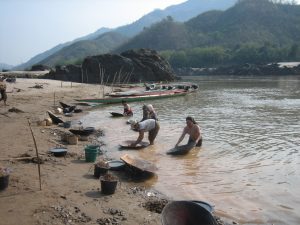Yesterday, Radio Free Asia (RFA) reported that Thai and Chinese investors have signed a power purchase agreement that opens the way to the construction of a third dam on the Mekong River in Laos.
The 770-megawatt Pak Lay project, which is slated for construction in Xayaburi province in northern Laos, is one of nine mega-dams that the Lao government is planning to build on the mainstream of the Mekong River. So far, two of these hydropower projects have been completed: the Xayaburi dam, which went online in October 2019, and the Don Sahong dam in southern Laos, which began operations in January of the following year. (Another huge dam, as Tom Fawthrop wrote in The Diplomat this week, is being built in alarming proximity to the UNESCO-listed town of Luang Prabang in northern Laos.)
The U.S.-funded broadcaster reported that the agreement between China’s Sinohydro Corp., Thailand’s Gulf Energy Development Public Co., Ltd., and the state-owned Electricity Generating Authority of Thailand (EGAT) was signed Wednesday. It quoted an official from the Ministry of Energy and Mines as saying that the work on basic infrastructure, such as an access road and bridge around the dam site, would start immediately.
Under the agreement, Gulf Energy Development holds a 40 percent stake in the project, with Sinohydro taking the remaining 60 percent. All of the power produced by the project will be sold to EGAT for the 29-year duration of the concession. The dam is expected to begin generating power in 2029.
According to RFA’s detailed past reporting on the project, Sinohydro earlier this year began preparatory work on the Pak Lay project, which is expected to displace around 3,500 people living in the vicinity.
The Pak Lay project is part of the Lao government’s long-standing ambition to transform itself into the “battery of Southeast Asia,” by harnessing its rivers for hydropower generation and exporting electricity to its fast-growing neighbors.
However, ecologists say that Vientiane’s dam-building spree is likely to compound the problems facing the Mekong and the 66 million people who rely on the river for their nutrition and livelihoods. In recent years, the lower half of the Mekong, which runs through Thailand, Myanmar, Cambodia, Laos, and Vietnam, has experienced a number of punishing droughts that have sent water levels to all-time lows. This has partly has been a result of El Nino weather patterns and the broader impacts of climate change, but environmentalists say that dam construction has amplified these effects.
Perhaps the most damaging have been on the upper reaches of the Mekong in China. Last year, the U.S.-funded Mekong Dam Monitor reported that “the impoundment of water and unnatural releases from dams have entirely altered the natural flow of the river” along certain stretches of the Mekong.
The signing of this power purchase agreement offers the latest indication that the government of Laos is bent on pressing ahead with its hydropower plans, even as the governments of Vietnam, Cambodia, and Thailand have expressed various reservations about hydropower projects. Vientiane’s dam-building mania has also contributed to Laos’ current heavy burden of foreign debt, much of it owed to Chinese state banks, which has pushed the country to the verge of economic crisis.
In early 2021, I wrote that Laos’ hydropower plans appear to have become “untethered from any solid economic rationale, driven overwhelmingly by the domestic interests that stand to benefit from dam construction.” With Vientiane forging ahead, there is no reason to revisit this assessment in 2023.
































